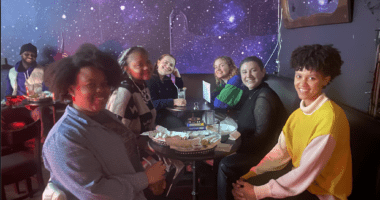The heart of my residency experience could perhaps be captured in two concepts: organized collaboration and creative flow. To simplify it even further, down to one word, the biggest impression left upon me so far has been of the balance that lies gracefully between these two themes. Author Julia Cameron says that,
In limits, there is freedom. Creativity thrives within structure
This fusion of ideas, which can seem like opposing concepts, is a constant undertaking in an arts residency.
I am currently shadowing two teaching artists, Max Albee (Visual Artist) and Katie Issel-Pitre (Writer), in a 1st grade class at P.S. 316 in Brooklyn, and the way they work together so seamlessly has made the biggest impression on me. They support each other without missing a beat, building off of each other’s concepts and balancing both art forms in their lessons skillfully. They are both extremely flexible and allow for a certain amount of spontaneity within their structured lessons.
The rituals and routines that Katie and Max have chosen for their residency embody this beautiful equilibrium between preparation and freedom. They begin with an opening ritual that has the group singing “Che Che Kule”, a call-and-response song from Africa, and they close the lesson with the “Peace / Power” chant by Paige Hernandez, which reminds the students of the “power of the head, power of the mouth, power of the heart.” Although fundamentally the same, the gestures that accompany the words change every week, and often students will be chosen to lead the ritual for their classmates. My mentors’ interactions during their lessons are always vibrant, but the energy of the room during these activities becomes absolutely electric. The students are highly engaged and they know what is expected of them within the formation, but they still have space to express themselves through improvisation.
During the first class I attended, we took the students on a neighborhood walk. Students were asked to draw three different buildings that they observed, such as a nearby church and/or their school, on distributed worksheets. The worksheets also had descriptive sentence prompts, with phrases like “The church is ____”, or “If I could change one thing about my school, I would _______.” I really appreciated the technique that my mentors used to broaden students’ understanding of artistic vocabulary around sensory detail and setting in a very age-appropriate way. Max had the students frame their eyes by holding their hands in a diamond shape, which he labeled “the viewfinder.” From my understanding, this device was not originally part of their lesson plan, but turned out to be a huge success with the class during the walk.
I did not realize the full impact of the co-teaching partnership until my second class at P.S. 316 the following week when Katie was out sick, leaving Max to assume full leadership of the activities, with myself and the classroom teachers assisting whenever possible. For the main activity, we guided the students through the completion of their group community collages that they had begun in a prior session. We also supported them in finishing the neighborhood walk worksheet, selecting edited lines with “juicy words” to form group stanzas. With only four adults present, Max had to supervise two tables, while Ms. Mc-Kie, Ms. Jean-Baptiste and I each supervised one.
This encounter cast co-teaching, one of the central foundations of Community-Word’s program, in a totally different light for me. Katie and Max seemed to have arranged their lessons so that they were continually passing the torch off to one another. In the previous lesson, Katie had been in charge of leading “Che Che Kule”. She would then hand the floor over to Max to explain the main activity and the accompanying artistic terms, and so on. One of the strongest lessons I have taken from the TATIP seminars thus far is that preparedness is key. I knew that glimpsing this in action was only the surface, and that there were several hours of prep work underneath that they had spent brainstorming together. The beauty of collaboration is in this balancing act, where great minds thinking alike can pool their resources and amplify each other’s energy.
If you have a colleague present, this same energy can also be put towards organizing your thoughts or transitioning to the next activity. With such small periods of time in which to work, I felt a deepened understanding and appreciation of how valuable this practice is, both for the TAs and for the classroom as a whole. When Teaching Artist partners can connect fully and arrange the seeds for creativity properly, it provides rich, future ground to nurture those unanticipated moments where the blossoming happens. It is fascinating to watch two artist with different backgrounds collaborate to create something new and exciting.
-Megan Skelly, Poet, TATIP Trainee



